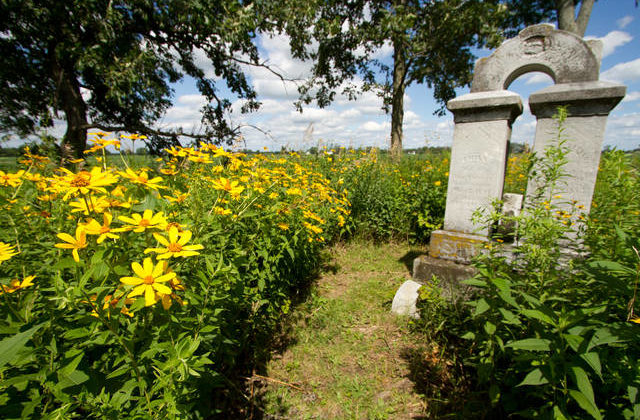
Neighboring cemeteries preserved original prairies
Story by Jane Beathard
Photos courtesy of Tom Arbour

When little Almira Andrews died in 1816 and was buried on a tiny patch of prairie in what would become northern Madison County, she had no way of knowing that her final resting place would one day be valued for its rare wildflowers and grasses.
Almira was only 5 when she succumbed to one of the many diseases — possibly malaria — that plagued early settlers of the soggy and mosquito-infested plains that lay between Big and Little Darby Creeks in those days.
In time, 113 other souls would come to rest near Almira in Smith Cemetery — named for Samuel Smith Jr., another area pioneer and Almira’s brother-in-law.
Not far west of the Smith plot, homesteaders Russell and Lucy Bigelow struggled to eke an existence out of “The Barrens” — as the Darby Plains were then called.
In the process they lost four children, burying each in another little piece of high ground near the Old Post Road (now State Route 161). Over the next 75 or so years, 98 more local residents were laid to rest near the Bigelow children in a place that would also become prized for its flora.
These Smith and Bigelow cemeteries are no longer places of interment. Burials stopped in the 1890s. Both are now state nature preserves, managed and protected by the Ohio Department of Natural Resources as two of the best examples of relict prairie in the state.
How did these tall-grass prairie remnants, normally found only farther to the West, end up in central Ohio? The answer pre-dates any trace of humans in the region.
Millions of years earlier, a warm, dry period followed the retreat of the last great glacier from the area. During that warm spell, “fingers” of prairie sod and plants moved in from the West, leaving the land between the Darbies different from the surrounding deciduous forests, according to Michelle Comer, manager of Smith and Bigelow cemetery preserves.
Tall grasses and wildflowers like false indigo, Bicknell sedge, purple coneflower, stiff goldenrod, ox-eye and wild petunia thrived there.
In the early 1800s, settlers from New England and Pennsylvania arrived to discover the marshy prairie (the French word for meadow) was not especially suitable for farming.
“It was too wet,” Comer said.
Those that stayed and survived the great malaria epidemic of 1822-‘23, were eventually rewarded. They and their descendants tamed the wetland with tile and drainage, turning it into some of the most productive cropland in the state.
The cemeteries, however, remained sacred places — untouched by plows and harrows. Prairie grasses and flowers continued to thrive in these .6-acre and .5-acre patches.
Modern times brought botanists to the area. They recognized the value of preserving these plant species — many of which are now rare or threatened — and urged the state to step in, Comer said.
Although both cemeteries remain the property of local townships, ODNR assumed management of Bigelow Cemetery in 1978 and Smith Cemetery in 1982.
While steps are taken to preserve the old tombstones as much as possible, flora comes first in both.
“Sometimes visitors are put off when the plants disguise the tombstones,” Comer said. “But we manage for plants.”
It’s an uphill battle, she admitted.
“We’re fighting succession and we want to protect the integrity of the cemeteries,” she said. “We remove saplings (except for a few bur oaks) and other invasives.”
Smith Cemetery is managed primarily for its grasses and is home to a total of 30 important plant species. Bigelow Cemetery has fewer grasses, but more flowers, among its 71 plant varieties.
Royal catchfly, an Ohio threatened species, is especially stunning at Bigelow, Comer noted.
“Hummingbirds love it,” she said with a laugh.
____
Late July and August are the best times to visit Smith and Bigelow Cemeteries State Nature Preserves. That is when the prairie grasses and wildflowers are at their peak, according to Michelle Comer, preserve manager.
Both are open seven days a week from dawn to dusk.
Smith Cemetery is located west of Plain City. Take State Route 161 west to Kramer Road which becomes Converse-Huff Road, then south on Converse-Huff to Boyd Road. Take Boyd Road west to the cemetery path.
Bigelow Cemetery is also west of Plain City. Take State Route 161 west to Rosedale Road, then south on Rosedale Road to the cemetery.
ID, 'source', true); $sourcelink = get_post_meta($post->ID, 'sourcelink', true); $sourcestring = '' . __('SOURCE','gabfire') . ''; if ($sourcelink != '') { echo "
$sourcestring: $source
"; } elseif ($source != '') { echo "$sourcestring: $source
"; } // Display pagination $args = array( 'before' => '' . __('Pages:','gabfire'), 'after' => '
', 'link_before' => '', 'link_after' => '', 'next_or_number' => 'number', 'nextpagelink' => __('Next page', 'gabfire'), 'previouspagelink' => __('Previous page', 'gabfire'), 'pagelink' => '%', 'echo' => 1 ); wp_link_pages($args); // Display edit post link to site admin edit_post_link(__('Edit','gabfire'),'','
'); // Post Widget gab_dynamic_sidebar('PostWidget'); ?>